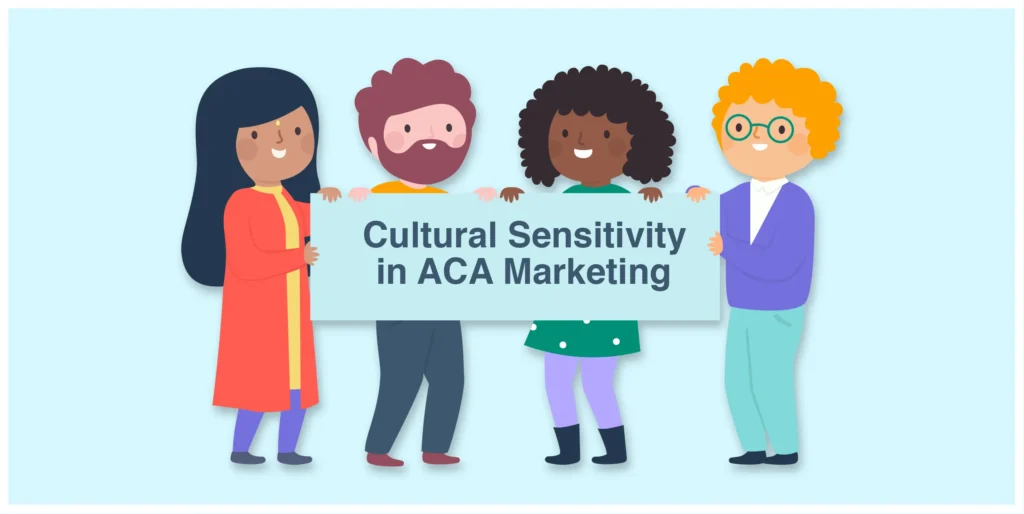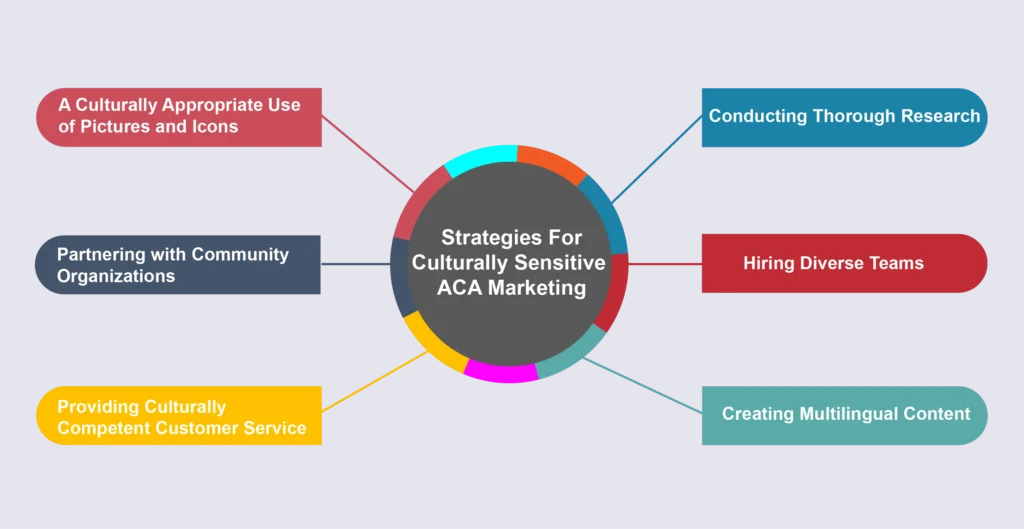
In 2024, the Affordable Care Act (ACA) achieved a historic milestone, with over 21 million individuals enrolling in Marketplace plans which is a significant increase from previous years.
This surge underscores the growing diversity within the U.S. healthcare system, highlighting the necessity for ACA marketers to adopt culturally sensitive strategies. Cultural sensitivity involves understanding and respecting the diverse cultural backgrounds of target audiences, enabling more effective communication and engagement. By integrating cultural awareness into marketing efforts, organizations can better connect with varied demographics, fostering trust and promoting health equity.
This guide delves into the importance of cultural sensitivity in ACA marketing and outlines actionable strategies for its implementation.
Read More: Why ACA Leads Are Crucial For Insurance Agents?
Key Takeaways:
- Enhanced Community Outreach: Partnering with local organizations boosts both reach and authenticity in ACA marketing.
- Increased Engagement: Implementing culturally sensitive strategies significantly raises enrollment among diverse demographics.
- Trust and Credibility: Tailored content that resonates with cultural nuances builds deep trust among targeted groups.
- Reduced Health Disparities: Culturally competent tactics are key to closing the health equity gap in underserved communities.
- Informed Strategies: Data-driven insights into demographic variations guide the development of impactful ACA campaigns.
Table of Contents
What Is Cultural Sensitivity In ACA Marketing?
Culturally competent marketing and outreach about the ACA therefore focuses on the consideration of cultural characteristics, and practices when creating and promoting awareness of the ACA act across the different population groups. This way, ACA-related information, services, and support are culturally appropriate and understood and could be successfully provided to people from different cultural backgrounds.
Here are some key aspects of cultural sensitivity in ACA marketing:
- Language Accessibility: Accurate, culturally relevant translations for non-English speakers.
- Culturally Relevant Messaging: Messages that resonate with cultural beliefs and avoid stereotypes.
- Inclusive Imagery and Symbols: Visuals that represent target populations authentically.
- Community Engagement: Partnering with local organizations to improve outreach.
- Cultural Competence Training: Training staff on cultural awareness and effective communication.
- Addressing Health Disparities: Recognizing and bridging health literacy gaps among cultural groups.
- Feedback and Adaptation: Gathering community feedback to refine strategies.
Importance of Cultural Sensitivity In ACA Marketing:
Culturally sensitive ACA marketing is crucial for expanding enrollment, building trust, and addressing health disparities.
- Enhancing Engagement and Enrollment: Culturally appropriate messages are more engaging and can increase enrollment rates by resonating with diverse communities.
- Achieving Trust and Credibility: Cultural sensitivity fosters trust, allowing communities to feel understood and valued in healthcare discussions.
- Addressing Health Disparities: Culturally competent strategies can help close health equity gaps by reaching underserved populations with relevant, accessible information.
Challenges Faced By ACA While Implementing Cultural Sensitivity:

Implementing cultural sensitivity in ACA marketing and outreach presents several challenges. These challenges stem from the complexity and diversity of the U.S. population, as well as the resource constraints and operational hurdles that organizations face.
Here are some of the key challenges:
1. Resource and Budget Constraints:
Developing cultural appropriateness of the media messages and campaigns takes time and money due to a lack of information on cultural differences, hiring translators, and adopting culturally sensitive marketing techniques. However, the financial constraints of the small organizations or those with fewer funds may likely lack the commitment to offer these activities proper attention.
2. Diverse and Changing Demographics:
Society of the United States comprises a large population, and they come from culturally diverse origins, speak different languages, and have diverse ways of living. Maintaining continuity with demographics and being able to retain every demographic group in the marketing of a product can sometimes be difficult.
3. Accurate Translations and Linguistic Nuances:
Notably, translating the materials accurately and at the same time making the translations culturally appropriate is a complicated task. What is more, many times the message itself might be distorted by simple direct translation, and important cultural references or idioms are not understood or are too weak to address the target audience.
4. Avoiding Cultural Stereotyping:
Currently, there is a danger of either portraying culture stereotypically or making cultural assumptions. The professionals involved in the development of the software must always make sure that they address all the cultural aspects in the community of the users appropriately without being too generalized.
5. Complex Health Literacy Levels:
In essence, the health literacy of the different cultural groups may vary in terms of the ACA information. Finding a middle ground where the messages developed meet the cultural sensitivity of the target audience as well as those with lower literacy levels makes a very herculean task.
6. Trust and Historical Distrust:
Some cultural groups may have had bad past experiences with government programs or healthcare and thus may avoid them. Eradicating the above-said mistrust and achieving credibility takes a long time and more importantly dedicated interaction with the community.
7. Operational Challenges and Training:
Cultivating cultural competence and sensitivity among all the employees entails constant efforts to train these staff. There are many challenges when it comes to taking cultural sensitivity concepts and applying them in organizations with numerous offices.
8. Balancing Cultural Sensitivity with Consistency:
While it’s important to tailor messages to specific cultural groups, maintaining a consistent overall message for the ACA is also crucial. Balancing these needs can be challenging, especially when trying to reach a broad audience.
9. Effective Community Partnerships:
Building and maintaining partnerships with community organizations and leaders is essential for culturally sensitive outreach. However, these partnerships require time, effort, and mutual trust, which can be difficult to establish and sustain.
Strategies For Culturally Sensitive ACA Marketing:

1. Conducting Thorough Research:
As a result, it is vital to conduct research on the audiences for designing culturally appropriate marketing campaigns. This encompasses otherwise acknowledging and appreciating their cultural aspects, values, beliefs, languages, and communication styles. Questionnaires, discussion groups, and direct interviews with the leaders of the community can be useful.
2. Hiring Diverse Teams:
Different marketing teams come with different ideas and views to the table. Marketing executives should have members of their team come from the demography of the target market to avoid wrong messaging.
3. Creating Multilingual Content:
Language is one of the major components of culture and therefore the understanding of the language of the people of a particular culture is very essential in the practice of cultural sensitivity. This means that giving marketing collages in other languages is more likely to close the gap and influence non-English-speaking communities. When dealing with translations it is obligatory to translate them properly as well as to know cultural differences in language usage.
4. Using Culturally Appropriate Visuals:
They establish meaning in communication and are hence considered very important. When creating the marketing material, one should consider incorporating the aspects of cultural sensitivity to appeal to the targeted group. Banish stereotyping and guarantee that it regards the diversification in the community within visual imageries
5. Partnering with Community Organizations:
Community organizations often have deep connections and trust within their communities. Partnering with these organizations can help ACA marketers reach their target audiences more effectively. These organizations can provide valuable insights and help distribute marketing materials through trusted channels.
6. Providing Culturally Competent Customer Service:
Ensuring that customer service representatives are culturally competent can enhance the overall customer experience. Training representatives to understand and respect cultural differences can help them communicate more effectively and build trust with potential enrollees.
Key Tips For Cultural Sensitivity In ACA Marketing:
- Ongoing Staff Training: Regularly educate staff on cultural sensitivity to maintain consistent, respectful messaging.
- Build Trust through Community Engagement: Collaborate continuously with community members for insight and to build genuine relationships.
- Seek Feedback for Improvement: Gather feedback from communities to adapt and refine marketing strategies.
- Share Stories and Testimonials: Use testimonials from community members to create relatable, impactful content.
- Maintain Transparency and Respect: Demonstrate respect for diverse perspectives to foster trust and inclusivity in marketing efforts.
Conclusion – Cultural Sensitivity In ACA Marketing:
Today’s diverse society requires ACA marketers to honor and integrate cultural sensitivity into their strategies. To ensure campaigns are impactful, marketers should research target groups’ cultural practices, hire diverse teams, and seek insights across departments. Translating materials and partnering with community organizations further enhances cultural relevance and stakeholder trust.
In conclusion, culturally appropriate ACA marketing builds trust and can help address health disparities and promote equity among people of color in the U.S.
FAQS:
Q: What is cultural sensitivity in healthcare?
Cultural sensitivity in healthcare means respecting diverse cultural perspectives in treatment and care, ensuring effective communication, and patient care that acknowledges individual cultural beliefs.
Q: What is the difference between cultural sensitivity and cultural competency?
Cultural sensitivity involves recognizing and respecting cultural differences, while cultural competency combines knowledge and skills to deliver effective healthcare across cultures.
